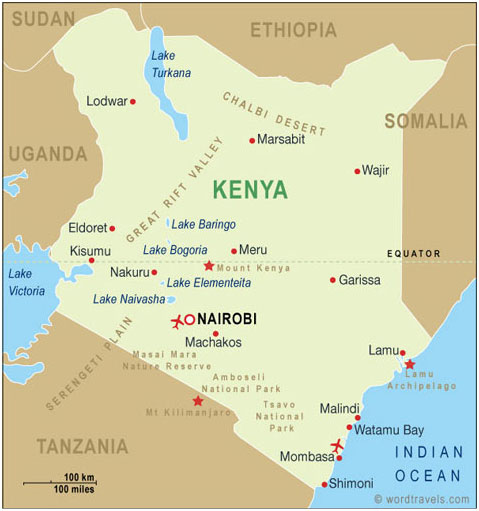Editorial
AJFAND and the 4th ANEC welcomes delegates and participants to Kenya!

Source: http://www.greenbusinessdirectory.com/Kenya.htm Accessed Sept 28,2010
Issue 38 is here to welcome participants of the 4th ANEC (Africa Nutritional Epidemiology Conference) to Nairobi, the Green City in the Sun. The conference is coming at a time that most Kenyans are feeling fairly up-beat about their own country. On August 4, 2010, Kenyans voted overwhelmingly (nearly 70% turnout) for a new constitution, which took more than 20 years to complete. So, Kenya is like a new baby to Kenyans and one we intend to nurture the way a loving mother would nurture her own child. It has been a difficult 47 years from the time the country attained independence in 1963, from the British. On December 12 in 1963, a flag was hoisted on the topmost tip of Mt Kenya to mark the birth of a new nation. We set out on an ambitious mission to rid Kenya of poverty, ignorance and disease. I left Kenya in 1968 to go and study in the USA. By the time we were attaining independence, I was 17 years old and had an idea that poor child feeding could affect the health of a child. As I proceeded for studies, I was determined to address that very issue. The University of Nairobi was offering Domestic Science ( Home Science), which my High School would not let me take because I was a science student, taking Physics, Mathematics, Botany, Zoology and, of course, Chemistry.
As it turned out, I was taking the right subjects but even as I studied in the USA, I decided to take some courses in meal management in preparation for what I saw ahead as a married life. Well, I am happy to see how far nutrition has come, even though we still have a long way to go in using what we know now to reduce world hunger and malnutrition. For a while there, up to the mid eighties, Kenya seemed to be doing well. We boasted of being able to feed the nation by the efforts of smallholder farmers. Farmers’ co-operatives were working, credit was available to them, and our government cared a lot about farmers then. What mistake my government and so many others made after independence was to listen to all kinds of advice and in the process lost sight of what they had set out to do for their people. Policies got made but were rarely implemented. Corruption and bad governance set in and words such as transparency and accountability became buzz words. National debts and conditionalities on loans by the IMF (International Monetary Fund) started to be understood by African intellectuals. Environment and related concerns were popularized. The donor community started to argue on the political side that democratization of governance structures would rid African countries of corruption, ensure equity and better use of national and donated resources. Majority of the Kenyan Youth became fairly frustrated and wondered what it was we got independence for. Those of my generation had a hard time explaining to our children that there actually was a great feeling when Kenya first got independence, and that most Kenyans then believed that diseases, such as malaria, that were killing both children and adults would be wiped out; yet today, malaria still kills many Kenyans. Also today, maternal mortality is on the increase as more and more women die in child delivery due to poor medical care infrastructure. Then there is poverty; this too is getting worse as more people lose livelihood capacity. At that time, it was believed that once economic poverty was addressed, so would many other maladies such as food poverty. As we know, however, food production and availability are not necessarily linearly correlated with better nutrition. Eradication of ignorance through education was one of the goals of the New Kenyan government in 1963. On the education front, Kenya has tried and, in fact,girl child education has received special attention and support. Of course, education was key to national and personal development and was directly linked to pursuit for a better life. To date, many Kenyans desire to receive a University degree.
The new constitution is indeed new. The referendum was conducted peacefully and the new constitution promulgated with no incident on August 27, 2010, when the national flag was once again hoisted on the tip of Mt Kenya. The problems that face the nation today are the same ones of 1963, except that they are compounded and the 2009 Census points to a total population of nearly 39 million against the 7 million of 1963. Population has grown at a faster rate than economic and food production growth.
About 73% of the Kenyan population is below 30 years of age. The challenges are enormous. What is different now is that the process leading to the new constitution was highly consultative, and Kenya now has a sizeable well qualified human resource, who can steer the country forward. There are also adequate checks and balances which, if applied properly can guarantee better democracy and more equity. Many Kenyans learnt a lesson in 2008, when the country broke into violence following a disputed presidential election results announcement.
Surely no one wishes to see a repeat of that.
We welcome our friends to Nairobi with open arms and assure them of Kenya’s well known warmth and hospitality. Let us all work in concert towards elimination of hunger and malnutrition from our midst and towards achievement of improved quality of life for our CHILDREN, and indeed towards the achievement of the United Nations Millenium Development Goals.What afflicts Africa can be wrestled down if we each play our role.
KARIBU SANA!
By
Ruth Oniang'o
Editor-in-Chief,
AJFAND




